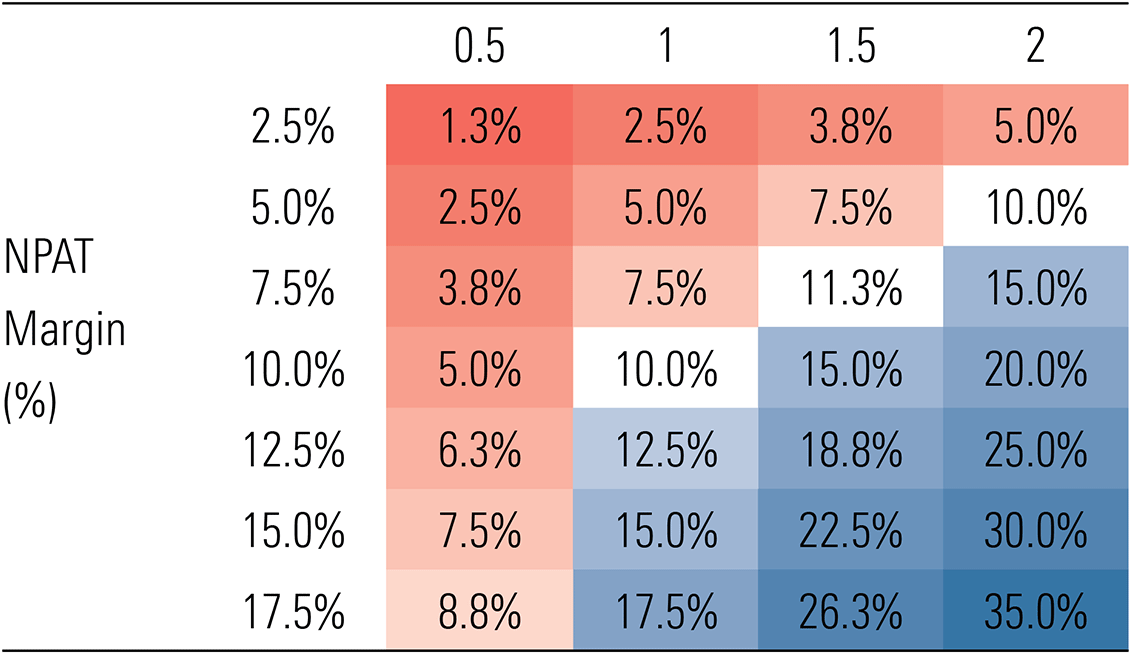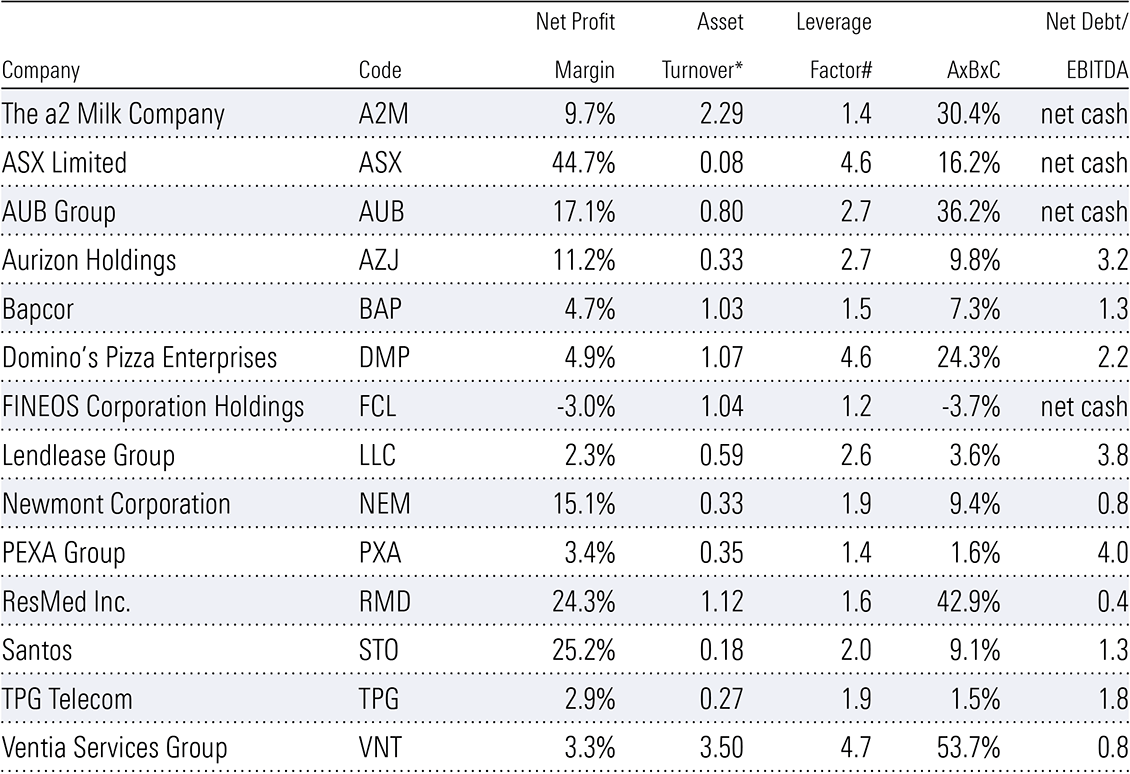Building
a
mental
map
for
equity
investing
involves
both
qualitative
and
quantitative
analysis: in
short, the
company’s
story, and
asking
whether
the
numbers
add
up.
In
my
past
overviews,
I’ve
talked
about
focusing
on
the
important
and
knowable
factors
when
evaluating
stocks,
clues
to
look
for
to
identify
diamonds,
and
what
to
do
to
create
your
own
financial
misery –
that
is,
what
to
avoid.
But
often,
ideas
and
business
investment
opportunities
present
themselves
as
numbers.
Is
starting
with
the
numbers
a
good
approach
to
spotting
opportunities?
It
certainly
can
be.
I
have
a
pretty
simple
and
fast
process
when
looking
at
financials.
It
allows
me
to
hone
in
on
where
to
look
and
where
to
question
when
it
comes
to
investment
analysis.
Using
this
approach,
I
look
for
clues
as
to
what
the
business
model
might
actually
be.
Is
it
a
revenue
growth
story?
Is
it
a
margin
story?
Is
it
cyclical?
Is
it
capital
intensive?
What
kind
of
returns
on
invested
capital
can
it
generate
and
how
have
those
been
trending?
These
questions
help
to
build
a
mental
model
from
financials
first,
rather
than
what
business
says
or
claims
are
its
successes.
Morningstar
Premium
has
plenty
of
financial
data
for
individual
companies,
whether
we
provide
analyst
coverage
on
them
or
not.
This
data
can
be
a
useful
starting
point.
What
is
a
Profit
&
Loss
Account?
First,
I
look
at
the
profit
and
loss
(or
P&L)
statement.
Revenue
growth
is
an
important
valuation
driver.
I
mainly
look
at
revenue
growth
and
margins.
In
the
former
case,
I
want
to
understand
if
this
business
is
growing
quickly.
Is
it
high
single
digits
or
more,
moderately
at
mid-single
digits,
slowly
at
low
single
digits,
or,
worse,
in
decline?
Depending
on
what
kind
of
growth
rate
the
business
has,
it
begs
the
question,
where
is
growth
coming
from?
Is
it
acquisitions,
product
rollouts,
market
growth,
market
share,
etc.
Understanding
the
qualitative
source
of
growth
can
be
an
important
factor
to
determine
if
it
can
continue
or
not.
Does
it
come
from
acquisitions,
or
organically,
or
a
mixture
of
both?
And,
if
the
business
has
had
a
setback,
this
can
be
an
opportunity.
Sometimes
structural
growth
stories
have
a
hiccup,
so
it
depends
on
what
drives
growth.
As
for
margins,
I
want
to
understand
if
it’s
a
high-
or
low-margin
business.
High
margins
can
be
associated
with
software
businesses,
for
example,
which
are
highly
scalable,
or
luxury
brands,
where
price
and
exclusivity
become
important
drivers
of
demand.
If
I
observe
low
margins
(say,
mid
to
low
single
digits
NPAT
margin),
then
I
become
very
interested
in
the
capital
efficiency
of
the
business:
that
is,
the
level
of
sales
relative
to
total
assets.
You
may
need
asset
turnover
of
two
times
or
more
to
make
the
economics
work.
Or
in
the
case
of
banks,
for
example,
a
lot
of
financial
leverage.
DuPont
analysis
very
simply
breaks
down
the
return
on
equity
of
a
business.
It
breaks
the
after-tax
return
for
every
dollar
of
equity
invested
in
a
business
into
three
key
components:
net
profit
margin
(NPAT/sales
revenue);
asset
turnover
(sales
revenue/total
assets);
and
leverage
(total
assets/shareholders
equity).
The
return
on
equity
is
the
product
of
the
three
factors.
The
upshot
is
if
net
profit
margins
are
low,
then
asset
turnover
needs
to
be
high
to
generate
high
returns
on
equity.
All
else
equal,
we
want
high
returns
on
equity
because
it
means
for
every
pound
of
equity
in
the
business,
it
generates
an
attractive
return.
What
is
Cash
Flow
and
How
do
I
Understand
it?
Second,
I
usually
look
at
the
cash
flow
statement,
starting
with
operating
cash
flow.
With
operating
cash
flow,
I
want
to
see
if
a
company’s
reported
profit
translates
into
operating
cash
flows,
or
just
a
mountain
of
assets
on
the
balance
sheet.
Some
capital-intensive
businesses
simply
grow
their
asset
bases
in
a
boom,
ploughing
everything
they
earn
in
profit
back
into
more
stuff.
Mining
equipment
hire
company
Emeco
has
fit
this
bill
before,
spending
money
to
grow
when
the
market
is
rising.
It
is
a
capital-intensive
cyclical
business,
and
its
capital
does
not
scale:
i.e.,
to
get
bigger,
it
needs
more
equipment.
Seeing
how
much
capital
is
going
out
the
door
helps
me
assess
if
the
company
is
investing
rapidly
and
if
it
is
translating
into
commensurate
profit
growth.
What
I
generally
dislike
is
a
combination
of
no
free
cash
flow,
and
declining
returns
on
invested
capital.
Large
investments
ahead
of
some
future
payoff
can
be
an
exception,
but
good
businesses
invest
as
they
grow,
and
superior
businesses
require
little
capital
to
grow.
In
the
hypothetical
good
business,
you
may
see
stable
but
attractive
returns
on
invested
capital
as
the
business
grows.
For
a
superior
business,
you
may
get
rising
returns
as
the
business
grows.
What
is
a
Balance
Sheet?
When
comparing
return
on
equity,
one
factor
to
look
for
is
financial
leverage.
This
is
debt,
or
money
borrowed
by
a
company
to
complete
important
projects.
A
business
may
earn
slim
margins,
and
slimmer
margins
than
peers,
but
earn
an
attractive
return
on
equity
because
of
excessive
financial
leverage.
Here,
those
returns
can
evaporate
quickly.
In
such
cases,
it’s
important
to
consider
the
likely
variability
of
revenues
and
earnings,
and
if
financial
leverage
can
trigger
value
destruction
if
a
downturn
occurs.
We
don’t
know
when
a
downturn
may
strike,
but
we
can
have
a
go
at
understanding
the
consequences
if
it
does.
There
are
a
couple
of
ratios
to
look
at
to
get
an
idea
of
financial
leverage.
I
usually
look
at
net
debt/EBITDA,
and
if
elevated –
say
above
two –
I
might
then
also
look
at
EBIT/net
interest
to
see
how
much
coverage
the
business
has.
While
the
large
global
miners
have
generally
been
well
run
since
the
last
downturn
in
2015/16,
some
had
to
raise
capital
in
that
downturn,
Glencore
(GLEN)
included.
And
in
the
great
financial
crisis,
Rio
Tinto
(RIO)
had
a
large,
discounted
equity
raise.
When
profits
contract
quickly,
what
looks
like
a
reasonable
amount
of
leverage
can
become
risky.
Some
types
of
leverage
can
be
good
though,
such
as
free
float.
Berkshire
Hathaway,
while
running
a
conservative
balance
sheet,
has
compounded
returns
in
part
thanks
to
free
float
from
the
insurance
premiums.
This
is
when
policy
premiums
are
paid
by
consumers
to
insurance
companies
in
advance
of
claims,
leaving
a
ball
of
money
for
the
insurer
to
invest.
Importantly,
this
free
float
grows
as
the
business
grows,
meaning
a
growing
ball
of
money
to
invest
and
growing
earnings
from
it.
Insurance
brokers,
such
as
AUB,
also
benefit
from
free
float
as
premiums
are
collected
before
they
are
paid
to
the
insurers.
Interest
can
be
earned
in
the
meantime.
Putting
it
All
Together
Exhibit
1
below
shows
the
return
on
equity
assuming
no
financial
leverage
is
dependent
on
asset
turnover
and
net
profit
margin.
I’ll
make
two
observations.
Firstly,
the
greater
the
asset
turnover
i.e.,
the
less
capital
intensive
a
business
is,
the
higher
the
returns
on
equity.
Secondly,
the
higher
the
net
profit
margins,
the
higher
the
returns.
A
highly
capital-intensive
business
needs
high
margins
to
make
attractive
profits
and
returns.
While
a
capital
efficient
business
can
earn
low
margins
and
still
make
decent
returns.
Hypothetical
Unlevered
Returns
on
Equity
Exhibit
1:
Asset
turnover
(revenue/assets)

Source:
Morningstar
To
apply
the
data,
the
Exhibit
2
below
shows
our
year
one
forecasts
for
the
components
of
the
return
on
equity
for
our
best
ideas.
We
can
see
returns
for
Resmed,
ASX
and
Santos
are
driven
by
high
margins,
so
here,
our
comfort
around
the
ability
for
high
margins
to
continue
is
critical.
For
A2
Milk
and
Ventia,
capital
efficiency,
shown
by
asset
turnover
above
two,
is
the
key
driver
of
attractive
returns.
AUB
is
an
interesting
case,
benefiting
from
financial
leverage
despite
having
net
cash.
It
shows
the
benefit
of
good
leverage
from
free
float.
Exhibit
2:
Components
of
Return
on
Equity
For
Our
Best
Ideas

Source:
Morningstar.
*
Excludes
goodwill,
cash
and
investments.
#
Total
assets/shareholder
equity.
Aurizon
stands
out
with
low
asset
turnover
but
generates
solid
returns
on
equity
through
leverage
from
debt.
In
this
case,
financial
leverage
is
reasonable
given
the
reliable
underlying
contracted
revenues.
Some
businesses,
such
as
TPG
and
Fineos,
are
underearning
now.
The
product
of
net
profit
margins
and
asset
turnover
looks
poor.
But
for
these
two
we
expect
revenue
growth
and
fixed
cost
leverage
to
expand
margins
and
profits.
This
article
has
been
edited
and
republished
for
a
UK
audience
SaoT
iWFFXY
aJiEUd
EkiQp
kDoEjAD
RvOMyO
uPCMy
pgN
wlsIk
FCzQp
Paw
tzS
YJTm
nu
oeN
NT
mBIYK
p
wfd
FnLzG
gYRj
j
hwTA
MiFHDJ
OfEaOE
LHClvsQ
Tt
tQvUL
jOfTGOW
YbBkcL
OVud
nkSH
fKOO
CUL
W
bpcDf
V
IbqG
P
IPcqyH
hBH
FqFwsXA
Xdtc
d
DnfD
Q
YHY
Ps
SNqSa
h
hY
TO
vGS
bgWQqL
MvTD
VzGt
ryF
CSl
NKq
ParDYIZ
mbcQO
fTEDhm
tSllS
srOx
LrGDI
IyHvPjC
EW
bTOmFT
bcDcA
Zqm
h
yHL
HGAJZ
BLe
LqY
GbOUzy
esz
l
nez
uNJEY
BCOfsVB
UBbg
c
SR
vvGlX
kXj
gpvAr
l
Z
GJk
Gi
a
wg
ccspz
sySm
xHibMpk
EIhNl
VlZf
Jy
Yy
DFrNn
izGq
uV
nVrujl
kQLyxB
HcLj
NzM
G
dkT
z
IGXNEg
WvW
roPGca
owjUrQ
SsztQ
lm
OD
zXeM
eFfmz
MPk
